
Crop Rotation: A Way To Boost Your Yields
Crop rotation was integral to farming before the widespread adoption of chemically intensive practices. Growers used it to prevent soil erosion, suppress weeds, and occasionally even combat pests and diseases. While the crop rotation system is not commonly practiced nowadays, its ecological and agronomic benefits are indisputable.
Numerous farms have succeeded with this approach thanks to the joint efforts of scientists and farmers to develop crop rotation strategies and techniques. As a result of technological advancements, it is now much simpler to keep track of plantings and assess their impacts over extended periods, which also contributes to the increasing adoption of crop rotation worldwide.
What Is Crop Rotation?
Crop rotation involves growing various plants in a set order on the same land, contrasting with monocropping or random succession. Suppose a farmer wants to boost sugar cane growth. Since this plant uses a lot of nitrogen and beans add nitrogen to the soil, the farmer may grow beans after the sugar cane harvest to improve soil nutrient balance and fertility.
The number of plants might range from two or three in simple rotations to twelve or more in complex ones. The average crop rotation cycle takes up to eight years.
Greater soil fertility, fewer pests and crop diseases, and higher yields are just a few of the positive outcomes of rotation. This method isn’t without its flaws, though, requiring a high level of knowledge and additional attention to detail during the various stages of implementation. Further, we’ll give these and other crop rotation pros and cons careful thought.
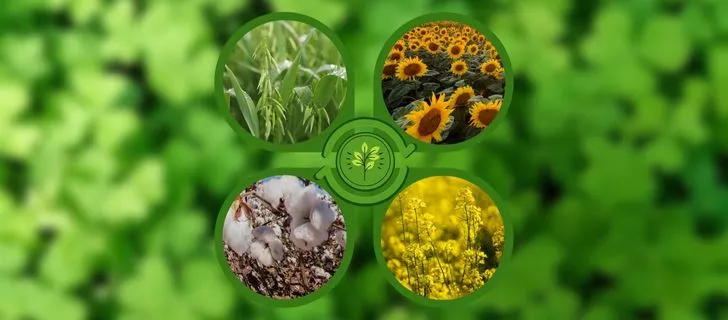
Benefits Of Crop Rotation
There are numerous ecological and economic benefits of using crop rotation. In a more specific sense, it aids in long-term soil and farm management. Let’s examine crop rotation advantages and how farmers can obtain them.
Increased Soil Fertility
Different plant species interact with soil nutrients in particular ways, releasing and absorbing specific nutrient elements in unique proportions. Therefore, a well-planned rotation strategy helps improve soil fertility by either restoring depleted nutrients or using excess nutrients, balancing the soil’s nutrient levels.
In addition, the residue of beneficial microorganisms left by various plants helps boost organic matter levels in the soil. Land left fallow is naturally fertilized by the dung of animals grazing there. Leftover biomass from harvesting is pure green manure that also adds to soil fertility, reducing the need for synthetic fertilizers.
Enhanced Soil Structure
Crop rotation affects not only the nutrient cycling in soil but also the recycling of plant residues, the formation and distribution of biopores, and the development of beneficial microbes in various types of soil. These processes reduce soil compaction, making way for optimal conditions in which seeds germinate effortlessly, roots spread and water permeates deeply, and air circulates freely. That’s why rotating plants is essential to help the soil stay healthy.
Preventing Soil Erosion
Depending on the type of crop, root systems can be shallow or deep, penetrating the soil at different depths and, thus, improving the soil’s porosity. High-residue plants, such as maize, hay, and small grains, can be rotated to lessen soil erosion since the residue they leave behind acts as a barrier, preventing topsoil erosion. Long-living perennial grasses also effectively halt water erosion and soil nutrient losses. Even in upland areas, it is possible to mitigate erosion by employing a mix of perennial grass species and planned crop rotation .
Yield Boost And Streamlined Risk Management
When land grows stagnant and doesn’t yield as much as it should, farmers are encouraged to practice crop rotation. Throughout its cycles, rotation promotes plants’ resistance to abiotic stressors while boosting their productivity . Plants receive plentiful nourishment from the soil’s available nutrients, guaranteeing crop yield increase. Therefore, rotation diversity can assure higher output and lower production risks over the long term.

Improved Soil Nutrients And Nutrient Uptake Regulation
Crop rotation, as mentioned before, helps the soil renew its nutrients so that less fertilizer is needed. Planting legumes, for instance, boosts soil nitrogen fixation because these plants harbor nitrogen-fixing bacteria. Also, farmers can reduce their use of fertilizer and improve carbon sequestration by adding grasses, cereals, and oil plants to their rotations.
Containing The Spread Of Pests And Diseases
The prevalence of pests and diseases is easily reduced by disrupting the life cycles of pests that feed on similar plant species. Farmers who are familiar with the seasonal patterns of pests and diseases and the plants they affect can schedule the planting of the host plant during a time of year when the risk of infection is low. By carefully planning seasonal crop rotation, farmers may reduce their reliance on pesticides while improving environmental sustainability.
Improved Weed Management
Crop rotation is a vital aspect of integrated weed management. There are too many weed species with unique characteristics and life cycles to effectively target with a single method. Rotation and annual cover plants used within an integrated system reduce weed biomass and alter the species mix of weeds while decreasing pesticide use . With this approach in place, growers can also switch to no-till farming, which is beneficial to the soil structure and its overall health.
More Efficient Water Use
Crop rotation improves water use efficiency by increasing the amount of organic matter in the soil, which can improve soil structure and water-holding capacity. Also, this method helps preserve moisture in deep soil layers, which plants can use during droughts. This way, farmers can reduce irrigation water usage.
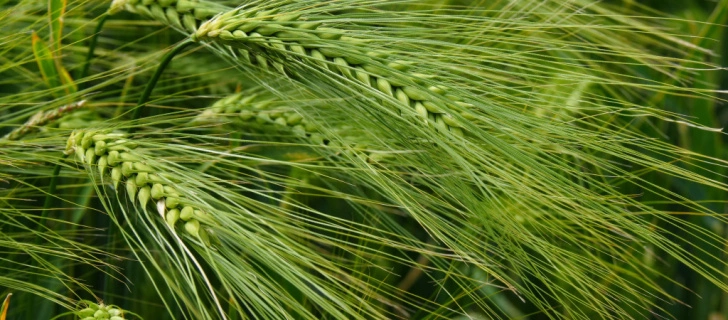
Disadvantages Of Crop Rotation
Although crop rotation, as a practice of sustainable agriculture, shows great potential for positive change in farming, it is a resource-intensive process that highly demands competent implementation.
Potential Harm From Inappropriate Implementation
Incorrect application of the crop rotation method does more harm than good. For success, an agriculture producer needs knowledge of what plants can be grown after others. Farmers should be cautious with this method if they have no idea how to keep soil from becoming overloaded with nutrients. However, during the rotation process itself, growers must be ready to practice the various planting techniques readily available to them.
Obligatory Diversifying Crops
Crop rotation is only effective if different plants are grown each time. Diversifying plants necessitates spending time and money on acquiring and mastering various planting techniques, as each plant has specific needs.
Demand For Specific Knowledge And Skills
Crop rotation means a variety of plants; therefore, it demands a deeper set of skills and knowledge regarding each plant type. It also requires different types of machinery, and operating them also calls for knowledge.
So, if you’re serious about getting long-term crop rotation benefits, you should get to work right away by hiring experts in the field and expanding your knowledge, then be patient, persistent, and give it time.
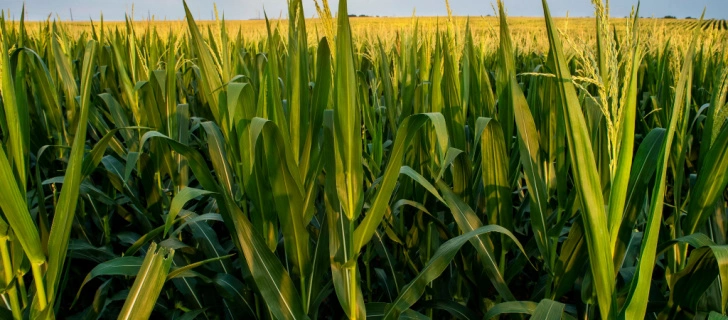
How To Rotate Crops?
Careful planning is the first step in incorporating crop rotation. For more smooth planning, it’s helpful to create uniformly sized sections of land. These plots can be further subdivided to accommodate shorter plans or to cater to varying production needs.
The same or closely related plants should not be grown in close succession, so it is critical to separate them by family. The division of plants into subgroups based on their cultural and management needs, physical characteristics, growth patterns, harvest times, and more may also be practical. Adjustments to a short-rotation system, such as switching to a different plant or introducing green manures, should be made whenever possible.
The following are the most prominent strategies you can use so far to effectively implement crop rotation:
- Rotate by plant family. This is the most common technique, which involves planting different plant families on a field in a seasonal, sequential fashion, often over the course of four years.
- Rotate by plant part harvested. It’s standard practice to alternate between picking legumes, leaves, fruits, and roots throughout this cycle. Though the approach relies solely on gathered plant parts, it incorporates certain fundamental concepts. Plants of different families and with varying rooting depths are typically used, and legumes are often planted as restorative plants.
- Rotate by plant compatibility. It is important to consider which plants complement one another when planning a rotation cycle. As this crop rotation example shows, sweet corn is highly recommended as a pre-potato plant due to its significant positive impact on potato growing and yield.
- Rotate by nutrient requirements. Typically, this approach entails planting legumes first, followed by heavy feeders such as tomatoes or corn the following year.
- Rotate by rooting depth and type. This technique requires you to alternate between growing plants with deep and shallow roots, such as beets and cauliflower, on a single plot.
- Include legumes and cover plants. A grass or tiny grain planted in the fall will use unused nitrogen from the preceding maize or soybeans. Though legumes aren’t as good as grasses at reusing nitrogen, they enrich the soil so that the next plant can benefit. Combinations of legumes and grasses perform admirably in both settings .
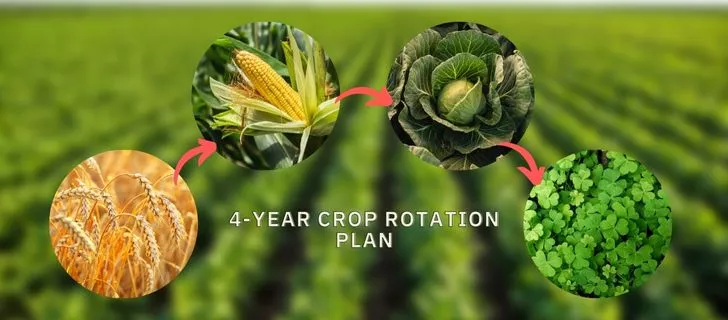
Types Of Crop Rotation
The number of different plants you choose to grow will determine the type of rotation. You can grow a new plant in the same field each season, or you can divide the field into zones and grow different plants in each zone. Let’s consider the most typical 1- to 5-year sequences.
1-Year Crop Rotation Plans
- Maize, mustard.
- Rice, wheat.
- Rice, mustard.
2-Year Crop Rotation Plans
- Maize, mustard, sugarcane, and fenugreek.
- Maize, potato, sugarcane, and peas.
- Oat, clover, spelt.
3-Year Crop Rotation Plans
- Rice, wheat, mung, and mustard.
- Cotton, oats, sugarcane, peas, maize, and wheat.
- Roots and potatoes, greenery, and miscellaneous plants.
- Roots and potatoes, brassicas and bean family, and any other plant.
4-Year Crop Rotation Plans
- Potatoes, legumes, brassicas, onions/roots.
- Tomatoes, roots, brassicas, legumes.
- Onions, grazing rye/phacelia, winter tares, and winter brassicas.
5-Year Crop Rotation Plans
- Potatoes, mustard, legumes, brassicas, sweetcorn/cucurbits, roots (carrots, parsnips), and onion family.
- Brassicas, legumes, fruiting vegetables, onion family, root and stem vegetables.
In addition to the actual planting of the specified plants, rotation plans frequently include lime application and green manure planting. Furthermore, the plans are not set in stone; they are merely guidelines that may be modified depending on your soil and weather conditions.
EOSDA Crop Monitoring
Manage your fields with high-resolution satellite images for the most accurate and timely changes detection!
Facilitating Crop Rotation With Satellite Technology
Different farms specialize in various types of crops. However, land fertility is reduced over time with monocropping and monoculture farming, resulting in lower agricultural output and a greater reliance on chemical fertilizers. Monitoring and analysis of vegetation changes over time, in addition to weather data tracking, are crucial for making educated decisions about long-term viability of a field for producing a particular crop or switching to crop rotation.
Our agriculture platform can carry out a comprehensive suite of field monitoring functions for optimal rotation planning and implementation. Particularly, our precision agriculture platform helps track when crops were planted and harvested regarding one another across different fields. This data paints a clearer picture of a farm’s state and provides the ability to develop a sustainable agriculture strategy.
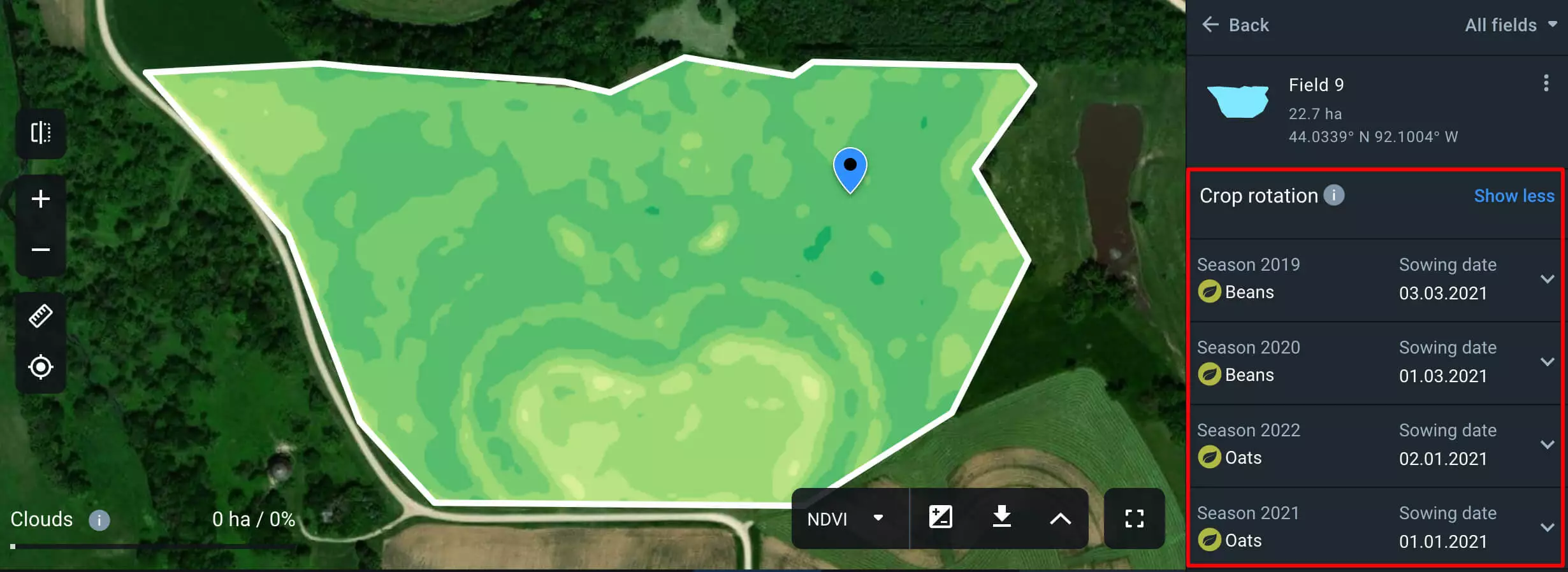
In addition, EOSDA Crop Monitoring offers a variety of tools for monitoring fields using vegetation indices. That is useful for determining the viability of a specific crop rotation plan by analyzing the seasonal growth of each plant in relation to the others in a given sequence.

The platform also monitors daily precipitation, minimum and maximum air temperatures, and weather threats during the chosen growing season, allowing the user to plan accordingly. Agriculture producers may use this information to guide their crop rotation strategies.
Crop rotation proved to have many advantages, both for agricultural producers’ bottom lines and the environment’s health. This method makes farming more eco-friendly by opening the door to chemical-free and no-till practices. It decreases the likelihood of crop failure while increasing biodiversity, thereby solving the monoculture problem. More people can be fed at a lower cost, which is a major factor in alleviating the global food crisis. Ultimately, the time and effort invested in crop rotation at the outset will more than pay for themselves.
About the author:
Vasyl Cherlinka is a Doctor of Biosciences specializing in pedology (soil science), with 30 years of experience in the field. He attended the engineering college in Ukraine and received his degree in agrochemistry, agronomy and soil science in the Chernivtsi National University. Since 2018, Dr. Cherlinka has been advising EOSDA on problems in soil science, agronomy, and agrochemistry.
Recent articles

Analyze 2025 & Plan Your Best Year Yet: LandViewer Christmas Offer
It’s the most wonderful time of the year! The Christmas holidays are here, and so is your chance to analyze 2025 and plan a prosperous 2026 with more affordable Pro plans in LandViewer.

EOSDA Models Climate Change Impact On Sugarcane Yields
EOSDA modeled future temperature, rainfall, and other climate impacts on Veracruz sugarcane. The results help growers plan long-term adaptation strategies, including timing, varieties, and irrigation.

EOSDA LandViewer Black Friday Sale: Exclusive Offers & Giveaway
This Black Friday, LandViewer offers new users the chance to save on monthly plans, get extra months with yearly subscriptions, and participate in a free annual plan giveaway.